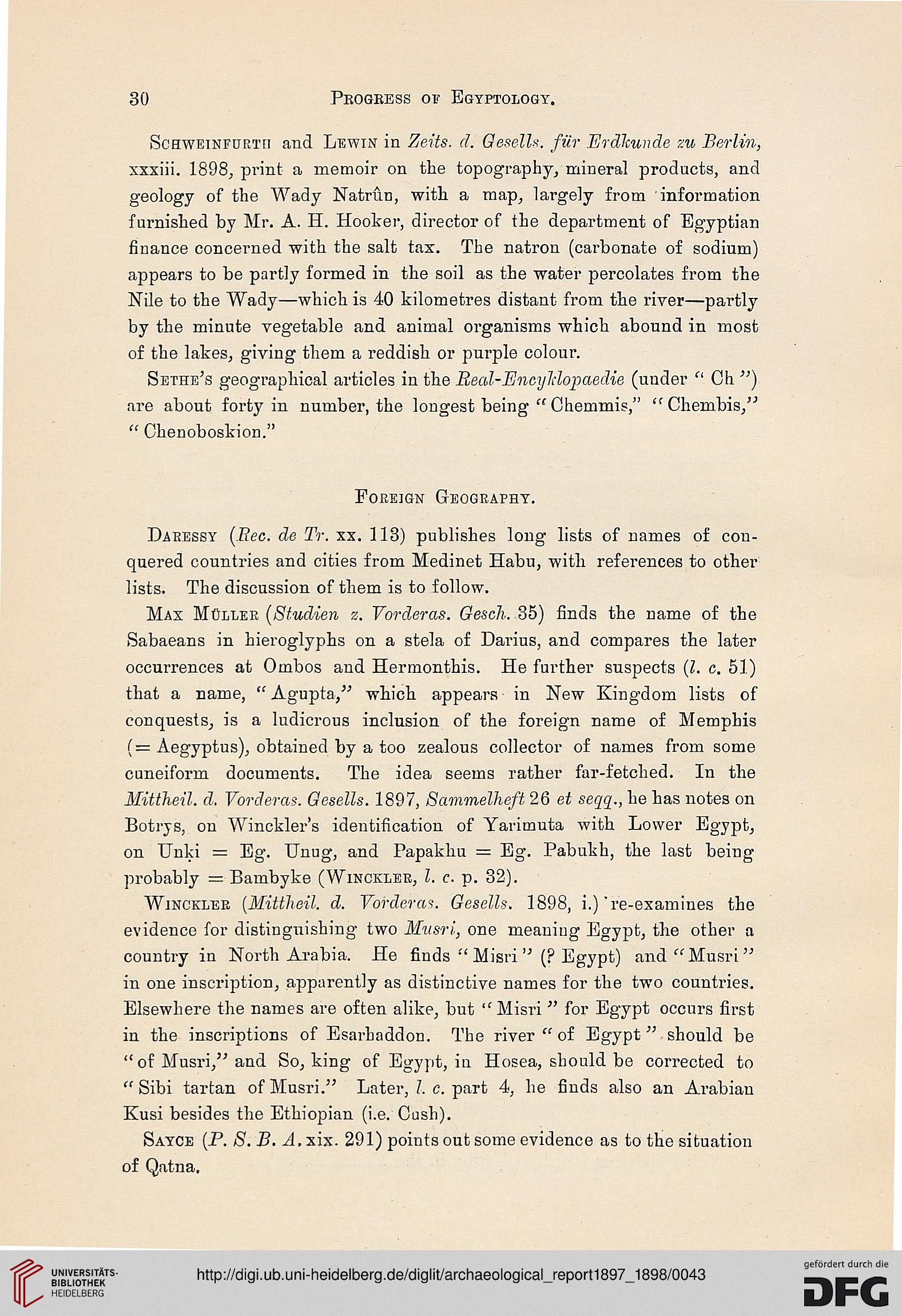30
Peogress of Egyptology.
Schweinfurtfi and Lewis in Zeits. d. Gesells. fiir Erdkunde zu Berlin,
xxxiii. 1898, print a memoir on the topography, mineral products, and
geology of the Wady Natrfin, with a map, largely from information
furnished by Mr. A. H. Hooker, director of the department of Egyptian
finance concerned with the salt tax. The natron (carbonate of sodium)
appears to be partly formed in the soil as the water percolates from the
Nile to the Wady—which is 40 kilometres distant from the river—partly
by the minute vegetable and animal organisms which abound in most
of the lakes, giving them a reddish or purple colour.
Sethe's geographical articles in the Real-Encylchpaedie (under " Ch ")
are about forty in number, the longest being " Chemmis," " Chembis,"
" Chenoboskion."
eobeign g-eogkaphy.
Daressy (Rec. de Tr. xx. 113) publishes long lists of names of con-
quered countries and cities from Medinet Habu, with references to other
lists. The discussion of them is to follow.
Max MOllek (Studien z. Vorderas. Qesch. 35) finds the name of the
Sabaeans in hieroglyphs on a stela of Darius, and compares the later
occurrences at Ombos and Hermonthis. He further suspects (I. c. 51)
that a name, " Agupta," which appears in New Kingdom lists of
conquests, is a ludicrous inclusion of the foreign name of Memphis
{— Aegyptus), obtained by a too zealous collector of names from some
cuneiform documents. The idea seems rather far-fetched. In the
Mittheil. d. Vorderas. Gesells. 1897, Sammelheft 26 et seqq., he has notes on
Botrys, on Winckler's identification of Yarimuta with Lower Egypt,
on Unki = Eg. Unug, and Papakhu = Eg. Pabuhh, the last being
probably = Bambyke (Wincklee, I. c. p. 32).
Wjncklee (Mittheil. d. Vorderas. Gesells. 1898, i.)'re-examines the
evidence for distinguishing two Musri, one meaning Egypt, the other a
country in North Arabia, He finds " Misri " (? Egypt) and "Musri"
in one inscription, apparently as distinctive names for the two countries.
Elsewhere the names are often alike, but " Misri " for Egypt occurs first
in the inscriptions of Esarhaddon. The fiver "of Egypt" should be
"of Musri," and So, king of Egypt, in Hosea, should be corrected to
" Sibi tartan of Musri." Later, I. c. part 4, he finds also an Arabian
Kusi besides the Ethiopian (i.e. Cash).
Sayce (P. S. B. A. xix. 291) points out some evidence as to the situation
of Qatna,
Peogress of Egyptology.
Schweinfurtfi and Lewis in Zeits. d. Gesells. fiir Erdkunde zu Berlin,
xxxiii. 1898, print a memoir on the topography, mineral products, and
geology of the Wady Natrfin, with a map, largely from information
furnished by Mr. A. H. Hooker, director of the department of Egyptian
finance concerned with the salt tax. The natron (carbonate of sodium)
appears to be partly formed in the soil as the water percolates from the
Nile to the Wady—which is 40 kilometres distant from the river—partly
by the minute vegetable and animal organisms which abound in most
of the lakes, giving them a reddish or purple colour.
Sethe's geographical articles in the Real-Encylchpaedie (under " Ch ")
are about forty in number, the longest being " Chemmis," " Chembis,"
" Chenoboskion."
eobeign g-eogkaphy.
Daressy (Rec. de Tr. xx. 113) publishes long lists of names of con-
quered countries and cities from Medinet Habu, with references to other
lists. The discussion of them is to follow.
Max MOllek (Studien z. Vorderas. Qesch. 35) finds the name of the
Sabaeans in hieroglyphs on a stela of Darius, and compares the later
occurrences at Ombos and Hermonthis. He further suspects (I. c. 51)
that a name, " Agupta," which appears in New Kingdom lists of
conquests, is a ludicrous inclusion of the foreign name of Memphis
{— Aegyptus), obtained by a too zealous collector of names from some
cuneiform documents. The idea seems rather far-fetched. In the
Mittheil. d. Vorderas. Gesells. 1897, Sammelheft 26 et seqq., he has notes on
Botrys, on Winckler's identification of Yarimuta with Lower Egypt,
on Unki = Eg. Unug, and Papakhu = Eg. Pabuhh, the last being
probably = Bambyke (Wincklee, I. c. p. 32).
Wjncklee (Mittheil. d. Vorderas. Gesells. 1898, i.)'re-examines the
evidence for distinguishing two Musri, one meaning Egypt, the other a
country in North Arabia, He finds " Misri " (? Egypt) and "Musri"
in one inscription, apparently as distinctive names for the two countries.
Elsewhere the names are often alike, but " Misri " for Egypt occurs first
in the inscriptions of Esarhaddon. The fiver "of Egypt" should be
"of Musri," and So, king of Egypt, in Hosea, should be corrected to
" Sibi tartan of Musri." Later, I. c. part 4, he finds also an Arabian
Kusi besides the Ethiopian (i.e. Cash).
Sayce (P. S. B. A. xix. 291) points out some evidence as to the situation
of Qatna,





